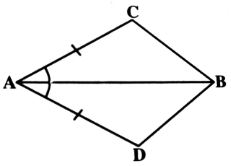- Introduction
- Exercise 2.1 - part 1
- Exercise Problems-2.1 - Part 2
- Exercise 2.2
- Exercise 2.3- part 1
- Exercise 2.3 - part 2
- Algebraic Identities
- Example Problems-2.4
- Exercise 2.4 - part 1
- Exercise Problems 2.4 - part 2
- Exercise Problems 2.4 - part 3
- Exercise 2.5 - Part 1
- Exercise Problems 2.5 - part 2
- Introduction
- Surface Area and Volume of a Cube
- Surface Area and volume of a Cuboid
- Surface Area and Volume of a Right Circular Cylinder
- Surface Area and Volume of a Hollow Right Circular Cylinder
- Surface Area and Volume of a Right Circular Cone
- Surface Area and Volume of a Sphere
- Surface Area and Volume of a Hemisphere
- Exercise 10.1
Exercise 7.1
Exercise 7.1
1.In quadrilateral ACBD, AC = AD and AB bisects ∠A

Sol.Given that AC=AD
\angle BAC =\angle BAD
Now in \Delta ABC
AC=AD (\because
\angle
AB=AB (common side)
\therefore \Delta ABC\cong \Delta ABD
(\because
2.ABCD is a quadrilateral in which AD = BC and ∠DAB = ∠CBA

Sol.i)Given that AD=BC and \angle DAB=\angle CBA
Now in \Delta ABD
AB=AB (\because
AD=BC (\because
\angle DAB=\angle CBA
\therefore \Delta
(\because
ii)From i)AC=BD (\because
iii)\angle ABD=\angle
3.AD and BC are equal and perpendiculars to a line segment AB. Show that CD bisects AB.

Sol.Given that AD=BS
\angle BOC=\angle AOD
\angle OBC=\angle OAD
BC=AD
(\therefore \Delta OBC\cong \Delta OAD
\therefore
Also OD=OC
\therefore
\Rightarrow
4.l and m are two parallel lines intersected by another pair of parallel lines p and q . Show that ΔABC≅ ΔCDA

Sol.Given that l \parallel
In \Delta ABC and \Delta CDA
\angle BAC=\angle DCA
\angle ACB=\angle CAD
AC=AC
\therefore \Delta ABC\cong \Delta CDA
5.In the adjacent figure, AC = AE, AB = AD and \angle BAD = \angle EAC

Sol.Given that AC=AE,AB=AD and \angle BAD=\angle EAC
In \Delta ABC
AB=AE
AC=AE
\angle BAD=\angle EAC
\therefore \Delta ABC\cong \Delta ADE
\Rightarrow BC = DE(CPCT)
6.In right triangle ABC, right angle is at C, M is the mid-point of hypotenuse AB. C is joined to M and produced to a point D such that DM = CM. Point D is joined to point B (see figure). Show that
 i) ΔAMC≅ ΔBMD
i) ΔAMC≅ ΔBMD
(ii) ∠ DBC
(iii)ΔDBC ≅ ΔACB
(iv)CM=\frac{1}{2}AB
Sol.Given that \angle c=90^{\circ}
M is mid point of AB;
DM=CM (i.e., M is mid point of DC)
 i)In \Delta AMC
i)In \Delta AMC
AM=BM (\because
CM=DM (\because
\angle AMC=\angle BMD
\therefore \Delta AMC\cong \Delta BMD
ii)\angle MDB=\angle MCA
But these are alternate interior angles for the lines DB and AC and DC as transversal.
\therefore DB\parallel AC
As AC \perp BC ; DB
\therefore \angle DBC
iii)in \Delta DBC
DB=AC (CPCT of \Delta BMD
\angle DBC=\angle ACB 90^{\circ}
BC=BC(common side)
\therefore \Delta DBC\cong \Delta ACB
iv)DC=AB (CPCT of \Delta DBC
CM= \frac{1}{2} AB
7.In the adjacent figure ABCD is a square and ΔAPB
 Sol.Given that ABCD is a square.
Sol.Given that ABCD is a square.
\Delta APB
Now in \Delta APD
AP=BP (\because
AB=BC (\because
\angle PAD=\angle PBC
\therefore \Delta APD\cong \Delta BPC
8.In the adjacent figure ΔABC
(Hint:compare \Delta APB

Sol.Given that \Delta ABC
Now in \Delta APB
AP=AQ (given)
AB=AC (given)
\angle PAB=\angle QAC
\therefore \Delta APB\cong \Delta AQC
\therefore \overline{PB}=\overline{QC}
9.In the figure given below \Delta ABC

Sol.Given that D is the mid point of BC of \Delta ABC
DF\perp
DE\perp
In \Delta BED
\angle BED=\angle CFD
BD=CD (\because
ED=FD (given)
\therefore \Delta BED\cong \Delta
10.If the bisector of an angle of a triangle also bisects the opposite side, prove that the triangle is isosceles.
Sol. Let \Delta ABC
Let \Delta ABC
the bisector of \angle
To prove: \Delta ABC
We know that bisector of vertical angle divides the base of the triangle in the ratio of other two sides.
\therefore \frac{AB}{AC}=\frac{BD}{BC}
Thus \frac{AB}{AC}
\Rightarrow
Hence the triangle is isosceles.
11.In the given figure ABC is a right triangle and right angled at B such that \angle ABC = 2 \angle BAC

(Hint : Produce CB to a point D that BC = BD)
Sol. Given that \angle B=90^{\circ};\angle BCA=2\angle BAC
Given that \angle B=90^{\circ};\angle BCA=2\angle BAC
To prove:AC=2BC
Produce CB to a point D such that
BC=BD
Now in \Delta ABC
AB=AB (common)
BC=BD (construction)
\angle ABC=\angle ABD
\therefore \Delta ABC\cong ABD
Thus AC=AD and \angle BAC=\angle BAD=30^{\circ}[CPCT]
[\because If \angle BAC=X then \angle BCA=2X
X+2x=90^{\circ}
3x=90^{\circ}
\Rightarrow X=30^{\circ}
\therefore \angle ACB=60^{\circ}]
Now in \Delta ACD
\angle ACD=\angle ADC=\angle
\therefore \angle ACD
\Rightarrow AC=2BC



0 Doubts's